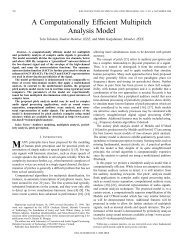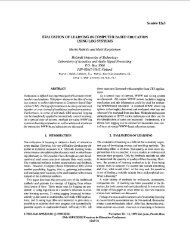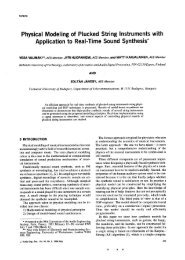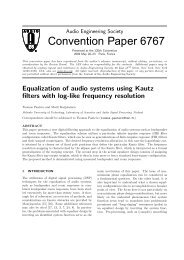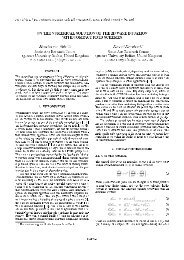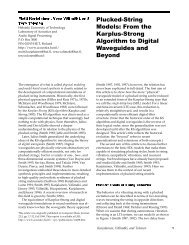where N is <strong>the</strong>1w0=I 0.8tZcl2 0.60.40.2n " 0 0.1 0.2 0.3 0.4 0.5. 0.6 0.7 0.8 0.9 1NORMALIZED FREQUENCY(a)6. a) Magnitude and h) phase delay responses r,fLagrange interpolatingfilters of length L = 2, 3, 4, 5, and 6 with d = 0.5.-0.1\'\~ ( z = ) z-" for D = 0,1,2, ... N (41)or that for integer values of <strong>the</strong> desired delay <strong>the</strong> approximationerror is set to zero. The solution can be given in anexplicit form ash(n) = n-D-kk0n-kitn,for n =0,1,2 ,... N(42)Naturally, here <strong>the</strong> integer part of D is zero so that D = d.The amplitude and phase delay responses of low-order Lagrangeinterpolators are shown in Fig. 6 for d = 0.5 and N =1,2, ..., 5 (L = 2,3, ..., 6; only <strong>the</strong> fractional part of <strong>the</strong> phasedelay is shown). It is seen that, due to <strong>the</strong> coefficient symmetryfor d = 0.5, <strong>the</strong> even-length filters (L = 2, 4, and 6) areexactly linear-phase, but <strong>the</strong> magnitude responses suffer from<strong>the</strong> zero at W=T. The odd-length filters (L = 3 and 5) havebetter magnitude responses, but <strong>the</strong> phase delays are worse.The = corresponds to linear interpolation be- This magnitude-phase delay tradeoff between even and oddtweentwo In this <strong>the</strong> two coefficients are length filters is similar for o<strong>the</strong>r fractional delay values andfor o<strong>the</strong>r approximation methods as well.h(0) = 1 - D, h(1) = D (43)Lagrange interpolation has several advantages: easy explicitformulas for <strong>the</strong> coefficients, very good response at lowJANUARY 1996 <strong>IEEE</strong> SIGNAL PROCESSING MAGAZINE 41
frequencies, and a smooth magnitude response. The maximumof <strong>the</strong> magnitude response never exceeds unity when<strong>the</strong> delay is near to half <strong>the</strong> filter length. This is important inapplications including feedback. On <strong>the</strong> o<strong>the</strong>r hand, <strong>the</strong> approximationerror is often unnecessarily small at low frequencies,at <strong>the</strong> cost of <strong>the</strong> performance at higher frequencies.Examples of Lagrange interpolator design with different valuesof d are shown in Fig. AS.Lagrange interpolation has been proposed for <strong>the</strong> approximationof a fractional delay independently by Laine [58] andby Liu and Wei [66, 671. In <strong>the</strong> context of multirate filters,<strong>the</strong> Lagrange interpolation scheme has been known for a longtime [24, 80, 971. KO and Lim [48] derived a general maximallyflat frequency-error solution at an arbitrary frequency@=WO, which with <strong>the</strong> choice WO reduces to Lagrange interpolation.The explicit (complex-valued) solution for <strong>the</strong> case ofnonzero WO was presented by Hermanowicz [37]. The maximallyflat FIR FD design has also been discussed by Sivanandet al. [lOl, 1021.In [73], <strong>the</strong> maximally flat interpolator design wasachieved by truncating <strong>the</strong> Taylor series of <strong>the</strong> error function(IS) and by forcing <strong>the</strong> derivatives in <strong>the</strong> Taylor series to bezero at o= 0 0 In [49] it was shown that <strong>the</strong> Lagrange solutionEq. 42 can also be obtained from <strong>the</strong> ideal sinc solution Eq.18 using <strong>the</strong> windowing method. The window coefficients arecomputed using <strong>the</strong> binomial formula.Also o<strong>the</strong>r polynomial interpolation techniques, such assplines [137], have been suggested for fractional delay approximationor interpolation. These techniques are nonoptimalfrom <strong>the</strong> frequency-domain viewpoint. Still, forapplications where good accuracy at high frequencies is notrequired, for example <strong>the</strong> parabolic interpolation technique[27] may be attractive since it can be implemented efficientlywith a third-order FIR filter.One can also construct a mixed approximation method byadding flatness constraints for a certain number of derivativesat in <strong>the</strong> general least squares approximation problem, employing<strong>the</strong> Lagrange multiplier method for <strong>the</strong> constraints asin [54] and [107]. An interesting technique for Taylor seriesapproximation of <strong>the</strong> sinc function was proposed in 11091.Minimax Design of FIR Fractional <strong>Delay</strong> FiltersBoth <strong>the</strong> least squares and <strong>the</strong> maximally flat approximationtechniques have <strong>the</strong> drawback that <strong>the</strong> peak error value in adefined approximation band cannot be controlled explicitly.For example, we may want to design a delay filter whose errorcharacteristics fit in a certain tolerance scheme, i.e., it isdesired to keep <strong>the</strong> peak approximation error in given limits.These kinds of specifications can be met using <strong>the</strong> minimax(Chebyshev) solution which, by definition, minimizes <strong>the</strong>maximum value of <strong>the</strong> error magnitude in <strong>the</strong> range of approximation,or(44)When certain conditions are met, <strong>the</strong> minimax solution isunique and equal to <strong>the</strong> equiripple solution, characterized byan oscillating error curve which attains <strong>the</strong> maxima at acertain number r of frequency points in <strong>the</strong> approximationinterval, i.e.,This is <strong>the</strong> case, for example, in <strong>the</strong> linear-phase approximationfor FIR filters with symmetric or antisymmetric impulseresponse where <strong>the</strong> error function reduces to areal-valued cosine series (with a possible weight function).The equiripple solution can be found by <strong>the</strong> iterative Remezexchange algorithm, as proposed by Parks and McClellan[83]. Unfortunately, Chebyshev approximation problems canusually be solved only by using iterative techniques.However, <strong>the</strong> fractional delay approximation is more troublesomethan <strong>the</strong> case of linear-phase FIR filters since <strong>the</strong>approximating function is complex-valued in general. Advancedalgorithms for complex approximation with minimaxerror characteristics have been presented in 141, [841, 1871,[98], and [41] and <strong>the</strong>y can also be applied to <strong>the</strong> problem athand. However, as <strong>the</strong> design procedures involve iterativealgorithms, <strong>the</strong>y are not suited for applications requiringreal-time coefficient update.A simplifying formulation for <strong>the</strong> minimax complex designin terms of real functions was proposed in [%]. Thecomplex task was split into two real-valued design problemswhich facilitates <strong>the</strong> use of <strong>the</strong> efficient Remez algorithm bya modification to <strong>the</strong> Parks-McClellan program [83]. A newalgorithm capable of full complex approximation was proposedin [41]. However, <strong>the</strong>se algorithms are not much betterfor real-time coefficient update since <strong>the</strong> Remez routine mustbe employed for each delay value.An approach that comes closer to real-time requirementswas proposed by Oetken [SO]. Considering <strong>the</strong> design ofeven-length interpolation FIR filters for sampling rate increaseusing a polyphase structure, <strong>the</strong> amplitude errors of <strong>the</strong>polyphase branches, when made equiripple, are almost exactlyproportional to each o<strong>the</strong>r. In particular, <strong>the</strong> zeros of <strong>the</strong>magnitude error function remain <strong>the</strong> same with high precision.When <strong>the</strong> coefficients of one branch are given, those ofany o<strong>the</strong>r branch can be solved via a set of linear equations.As one of <strong>the</strong> branches corresponds to an exactly linear-phasefilter with a symmetric impulse response, it can be designedoff-line using <strong>the</strong> standard Remez algorithm.Realizing that each polyphase branch actually approximatesa rational fraction of <strong>the</strong> unit delay, <strong>the</strong> method can bedirectly applied to our problem. Let us assume that <strong>the</strong> coefficientsof an Nth-order (or length L = (N + I), L even)symmetric FIR filter are given, <strong>the</strong> amplitude response ofwhich approximates unity in <strong>the</strong> equiripple sense in <strong>the</strong>passband [0, CYT], O






